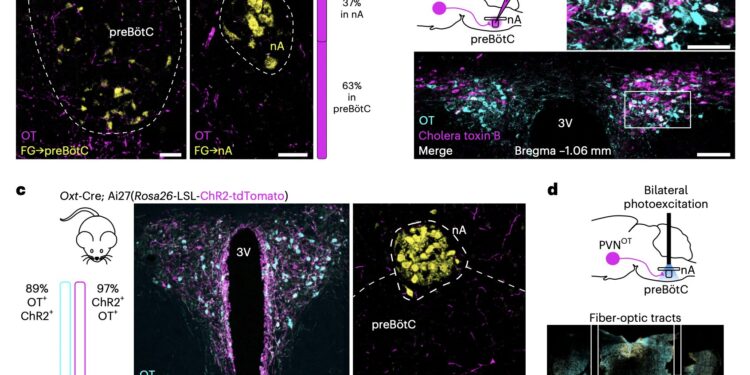OT fibers from the PVN caudal to preBötC/nA can amplify RespHRV, decrease mHR, and increase respiratory rate in freely moving adult mice at rest. Credit: Buron et al. (Nature Neurosciences, 2025).
When humans and other animals are in a calm state, they tend to breathe more slowly and their heart rate also slows down. Conversely, when they exercise or are under psychological stress, their breathing and heart rate tend to speed up.
The innate variation in time between heartbeats synchronized with respiration is described by the term respiratory heart rate variability (RespHRV). Synchronization between the heart and breathing is known to be an indicator of heart health and proper functioning of the autonomic nervous system.
In contrast, certain medical conditions, such as chronic heart failure or hypertension, have been associated with poor synchronization between the heart and respiration (i.e., decreased RespHRV). Although the health implications of RespHRV are well documented, the neural mechanisms that link respiratory rate to heart rate have not yet been clearly elucidated.
New research discovers neural pathway in mice
Researchers from Aix-Marseille University recently conducted a study in mice aimed at further elucidating the neural underpinnings of RespHRV. Their findings, published in Natural neurosciencesuggest that the neurotransmitter oxytocin (OT) modulates the timing of breathing and heart rate, via a recently discovered neural pathway that connects the hypothalamus, brainstem and heart.
“Relaxation and positive socio-emotional states can amplify RespHRV, but the underlying mechanism remains largely unknown,” Julie Buron, Ambre Linossier and colleagues wrote in their article. “We identify a hypothalamus-brainstem neuronal pathway in rodents by which OT amplifies RespHRV during calming behavior. OT neurons in the caudal paraventricular nucleus of the hypothalamus regulate the activity of a subgroup of inhibitory neurons in the pre-Bötzinger complex, the brainstem nucleus that generates the inspiratory rhythm.”
How oxytocin influences heart and breathing synchronization
To study the neurobiological underpinnings of RespHRV, Buron, Linossier and their colleagues conducted a series of experiments involving mice. Using a series of advanced imaging and experimental methods, they examined how OT release influenced the synchronization between the animal’s heart and breathing, while also tracking the influence of oxytocin-producing neurons on other brain cells.
This ultimately allowed them to discover a previously unknown pathway involving neurons in the hypothalamus, a population of brainstem neurons (i.e., the pre-Bötzinger complex), and the heart. The collective activity of these neurons and the release of OT modulate the synchronization between the heart rate and respiration of mice.
Potential for new therapies targeting stress and anxiety
“Specifically, OT enhances glycinergic input from neurons expressing OT receptors in the pre-Bötzinger complex to parasympathetic neurons innervating the heart in the nucleus ambiguus during inspiration,” the authors wrote. “This leads to an amplified respiratory modulation of the heart’s parasympathetic activity, thereby enhancing RespHRV. We show that OT neurons participate in the restoration of RespHRV amplitude during stress recovery in mice, indicating that OT acts centrally to regulate cardiac activity during calming behavior.”
The results of this recent study highlight the key role of OT in the synchronization between breathing and heart rate, while identifying the neural mechanisms by which this neurotransmitter could stimulate relaxation and RespHRV. Once the team’s findings are explored further and validated in other studies, they could inform the development of new therapeutic interventions that could facilitate recovery from stress or alleviate some of the symptoms of anxiety disorders.
Written for you by our author Ingrid Fadelli, edited by Gaby Clark, and fact-checked and revised by Robert Egan, this article is the result of painstaking human work. We rely on readers like you to keep independent science journalism alive. If this reporting interests you, consider making a donation (especially monthly). You will get a without advertising account as a thank you.
More information:
Julie Buron et al, Oxytocin modulates respiratory heart rate variability via a hypothalamus-brainstem-heart neuronal pathway, Natural neuroscience (2025). DOI: 10.1038/s41593-025-02074-2.
© 2025 Science X Network
Quote: Oxytocin helps synchronize heart rate and breathing, suggests newly discovered neural pathway (October 29, 2025) retrieved October 30, 2025 from
This document is subject to copyright. Except for fair use for private study or research purposes, no part may be reproduced without written permission. The content is provided for informational purposes only.



